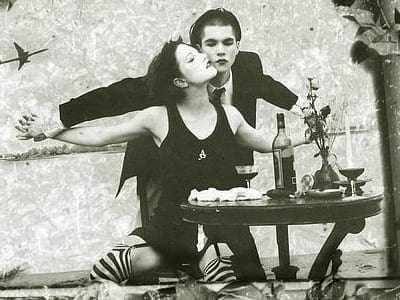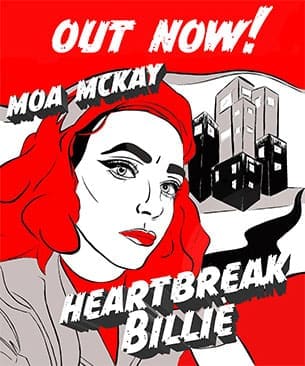Martin Bisi and friends show Sound and Chaos in West Germany this Tuesday, followed by concerts by MB and by Berlin post-punk band nunofyrbeeswax. Martin Bisi has had a long and illustrious career at his downtown New York studio where he recorded people including Swans, Violent Femmes, Brian Eno, Dresden Dolls, Afrika Bambaataa and many many more. We asked Martin a few questions, and this is what he said:
indieBerlin: You started BC studio when you were 17 and your first session was with Brian Eno. How did that come about?
[aesop_image img=”https://indierepublik.com/wp-content/uploads/2016/09/Martin-Bisi-still-from-music-video.jpg” align=”left” lightbox=”off” captionposition=”left”]
Martin Bisi: I was actually 19 during the first Eno session. 17 was my age when I met Bill Laswell, that’s what put me on the actual path to meeting Eno, and then having a more serious and committed vision for a studio.
In a sense Eno found us
Laswell reached out to him, initially very casually, like in the neighborhood even. And then Eno took more notice when Laswell started getting more session work as a bass player. And eventually Material got gigs in popular clubs.
Eno was very interested in meeting people in New York, for collaborations, but also to see what made the city tick. It’s a testament to No Wave, that Eno took interest, cause it’s really not his style. It’s like he was more fascinated by the dynamics of the movement.
And it was at a Material show, in a short-lived club just off Times Square, when i was doing sound, that Eno came and Laswell spilled the beans, that I was thinking of starting a studio in a mostly-vacant factory in Gowanus, Brooklyn.
He referred to the main street as “depression avenue”
[aesop_image imgwidth=”50%” img=”https://indierepublik.com/wp-content/uploads/2016/10/Bisi-BC-Studio-credit-Elizabeth-Graham-1.jpg” align=”right” lightbox=”off” captionposition=”left”]
So I took him there. I remember he was struck by how depressing the area was. He referred to the main street as “depression avenue”. But anyway, we went forward.
Through your time with BC Studio you recorded an amazing array of seminal records. Was there a point when you realised that you were working on a record, or with an artist, that would really strike a chord with the world – that you were involved in something unusually special?
Martin Bisi: I pretty much always called it wrong. I sometimes thought my immediate peers would like something. But nothing that really resonated, ever did I think would do well. It might be that things that do very well, have to have a lower common denominator, that maybe was hard for me to appreciate while I was in it. Also, I like working with artists that are maybe established locally, but that’s it. So there’s the factor that bands get better, at least initially when they get some success. They can tour extensively for the first time, so that can improve them, or break them of course.
When I recorded EVOL, they hadn’t toured the material – usually a mistake
[aesop_image img=”https://indierepublik.com/wp-content/uploads/2016/10/sonic-youth-evol-album-cover.gif” align=”left” lightbox=”off” captionposition=”left”]
Sonic Youth can be an example of improvement. When I recorded EVOL, they hadn’t toured the material – usually a mistake. So when I saw them in the latter part of the EVOL tour, the material had far exceeded the album. I felt kinda bad about that – but happy for them of course.
We would literally have a party and record it
indieBerlin: Of all the bands you recorded, what was the weirdest or craziest experience you had?
Martin Bisi: One thing that comes to mind, during the early hip hop era, there would occasionally be dance tracks that needed party sounds, like in a break. and there was no way back then, to grab that from another source. So we would literally have a party and record it. Glasses banging around, people calling out, laughing. Around 20 people would usually be ideal, so when we ran out of the usual crowd, that’s when it would get weirder and crazy. People I wouldn’t normally have, like friend-of-friends of gangsters, that sort of thing.
Lifelike recreations of taxidermied animals
indieBerlin: What was the most unusual request you had in terms of recording/engineering?
[aesop_image img=”https://indierepublik.com/wp-content/uploads/2016/10/Michael_Gira_by_Andy_Catlin.jpg” credit=”Andy Catlin” alt=”Michael Gira by Andy Catlin” align=”right” lightbox=”off” caption=”Michael Gira lived for a period upstairs at BC Studios as well as later recording there” captionposition=”left”]
Martin Bisi: I do tend to remember better the sessions for records that eventually were notable and discussed more. So with that in mind, Brian Eno in 1981 asking me to put up sheets to project images from slides of dioramas from the Natural History Museum, is definitely up there in unusual requests. These were lifelike recreations of taxidermied animals in their habitats – some very dramatic, like the savannas under Mt Kilimanjaro. Eno visited the museum that morning and called to say he was running home to get projectors, and if I could arrange some white sheets.
indieBerlin: You grew up in NY and started the studio in Brooklyn in ‘79, and you’ve been there being active through all this time – how has NY/Brooklyn changed in the years you’ve been there?
Money is bad. There’s reliance on wealthy patrons
Martin Bisi: At this point, when I think back on that era, it has crossed the line into being a completely different world, almost like when we look back at the Victorian era. But oddly, in the world of show biz, you can see a lot in common now, as with the Jazz age and even the Victorian era – Money is bad. There’s reliance on wealthy patrons. There are taste makers. There is division of labor, like there has to a promoter. And a community of like-minded artists and their friends is the foundation of strong work. One huge difference in New York is that when it was affordable, and cheap, then everyone had more privilege – things being relative.
I think if you transported me to the Victorian era, I would figure out what DIY meant then, find the anarchists, and get busy
indieBerlin: How is the music business different, in your experience, between say the 80s and now?
[aesop_image img=”https://indierepublik.com/wp-content/uploads/2016/10/The_Dresden_Dolls_-_The_Dresden_Dolls_EP.jpg” align=”left” lightbox=”off” caption=”The Dresden Dolls recorded their self-titled EP at BC Studios” captionposition=”left”]
Martin Bisi: As much as I laud DIY values, until now, there was more help. It was easier for people to start a small, or larger label, and then help their bands. So you could be a screw-up, and things could still happen. Now, those potential enablers can’t afford, because of the larger and music economy, to enable. And similarly, it’s harder to have a small, dedicated music venue in an accessible and central location, and have it last, which is important for fostering new sounds.
The key for me has been to stay in the same city, to ride it out
indieBerlin: What is it about BC studio that keeps bringing such big names / interesting artists to come and record there?
Martin Bisi: The open secret is that it’s up and down. It’s never been a steady stream. There’s been also tough times for music in New York, either when less interesting stuff is happening, or because aesthetics shift away from what I generally do – and then that affects me. The key for me has been to stay in the same city, to ride it out, and do so in a great, diverse city.
indieBerlin: You’re also a singer and songwriter – how would you describe your style / how would you describe your approach?
Martin Bisi: The general tie-in over the years has been emotional extremes, and a social or societal relevance. So in Sirens Of The Apocalypse, there was a lot of social critique via characters, imaginary people that each song was about, in a humorous way.
[aesop_image img=”https://indierepublik.com/wp-content/uploads/2016/10/Ramones-brain-drain-album-cover.jpg” alt=”Ramones Brain Drain Album Cover recorded at BC Studios by Bill Laswell” align=”right” lightbox=”off” caption=”Ramones Brain Drain Album Cover recorded at BC Studios by Bill Laswell” captionposition=”left”]
In Ex Nihilo it was about the insanity, literally of the experiences between 2009 and ’12 taken in a very long-range historical context – like referencing ancient human sacrifice when thinking about the corporate state. Or hunter-gatherer subsistence society when referencing Occupy Wall Street marches – also the last, instrumental 4 minutes of the album came from my thinking of the holocaust while watchin and fearing the rising waters near the studio during Hurricane Sandy – not sure what the connection would be there though.
And generally, emotionally very happy, or sad, or very afraid or angry.
indieBerlin: Your previous album, Son of a Gun, featured luminaries such as Bill Laswell, with whom you started BC Studio and Brian Viglione from the Dresden Dolls – do you have a fixed line-up these days or do you like to work with different people for each record?
Martin Bisi: Lately I’ve been playing everything myself except the drums and female vocals. That was a deliberate change after Son Of A Gun which was very collaborative. I like both approaches, and I’m about to go back to the collaborative. Actually, when in Europe i’ll record 2 new songs with the Berlin-based version of my band. So after a few shows, the 1st one being at West Germany, we’ll record. I’m also be bringing a US member to join in the Berlin band. Genevieve Kammel Morris, playing keys and viola will join Diego Ferri and Oliver Rivera-Drew who are based in Berlin.
indieBerlin: You’re playing in West Germany on 4.10 – is this your first time performing in Berlin?
Martin Bisi: Oh no. I’ve played Berlin around 7 times already. NK Projekt recently, and Loophole.
Maybe this is a good time to mention, that my last music video includes a member of the other band in the West Germany show, Nunofyrbeeswax. Angela Munoz, the drummer is one of the Mermaids in the video. The video was made in Berlin, by Berliner Edie Fuchs:
indieBerlin: You’re also showing this fascinating documentary covering the studio from its inception until now – who made the documentary, how did it come about and how do you feel about the result?
[aesop_image img=”https://indierepublik.com/wp-content/uploads/2016/10/Herbie_Hancock_-_Rockit.jpg” alt=”Herbie Hancock recorded Rockit with Martin Bisi at BC Studios” align=”left” lightbox=”off” caption=”Herbie Hancock recorded first ever mainstream song with scratching – Rockit – with Martin Bisi at BC Studios” captionposition=”left”]
Martin Bisi: I’m thrilled with the documentary, I think on its own it’s good art, it captures the vibe, mood and dynamics of the studio space, in addition to being informative, and at least honoring some of the varied artists who’ve worked there. The doc has also been a good vehicle for raising awareness of gentrification issues in Brooklyn. Some of the interest in the doc, and now in the studio, is of course because it is threatened.
There were 2 directors, Ryan Douglass and Sara Leavit, who will be at the West Germany screening and will answer questions in the q&a. They worked together in their day jobs as video editors, and were looking for a subject for a short film that overlapped their interests. It was fairly casual, almost just for fun – the doc was originally going to be 20 minutes, and that’s what I agreed to, though perfectly happy when they discovered a wealth of music and scene history hidden behind the walls. So the doc slowly expanded to its current, and maximum reasonable length.
indieBerlin: Fascinating. Thanks very much for your time, I’m looking forward to the 4th October at West Germany to check it out!
Martin Bisi: Thanks, indieBerlin!
Interview by Noel Maurice / Photo of Michael Gira by Andy Catlin under a CC2 Licence


